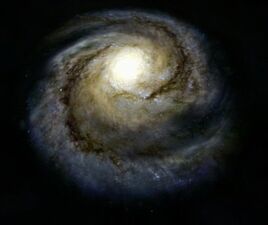No edit summary |
No edit summary |
||
| Line 1: | Line 1: | ||
| + | :''See also [[Galaxy class|''Galaxy'' class]].'' |
||
| ⚫ | |||
[[Image:Milky Way.jpg|thumb|268px|The [[Milky Way Galaxy]] as depicted in the ''[[USS Voyager (NCC-74656)|USS Voyager]]'s'' [[Astrometrics Lab]] in [[2374]]]] |
[[Image:Milky Way.jpg|thumb|268px|The [[Milky Way Galaxy]] as depicted in the ''[[USS Voyager (NCC-74656)|USS Voyager]]'s'' [[Astrometrics Lab]] in [[2374]]]] |
||
| − | :''If you are looking for ''Galaxy'' class starships, go [[Galaxy class|here]].'' |
||
| − | |||
A '''galaxy''' is a dense of cluster of millions of [[star]]s, [[Nebula|nebulae]] and various other matter which is held in place by a massive gravitational attraction (such as a super massive blackhole). |
A '''galaxy''' is a dense of cluster of millions of [[star]]s, [[Nebula|nebulae]] and various other matter which is held in place by a massive gravitational attraction (such as a super massive blackhole). |
||
| Line 8: | Line 6: | ||
Galaxies can take on many shapes and sizes, our own galaxy the [[Milky Way Galaxy|Milky Way]] is a ''Spiral Galaxy'' so is naturally divided into a number of spiral arms, never the less it is a common practice as means of general galactic charting by many races to divided the Milky Way into four equal [[Quadrant]]s. |
Galaxies can take on many shapes and sizes, our own galaxy the [[Milky Way Galaxy|Milky Way]] is a ''Spiral Galaxy'' so is naturally divided into a number of spiral arms, never the less it is a common practice as means of general galactic charting by many races to divided the Milky Way into four equal [[Quadrant]]s. |
||
| − | In addition to the main body of a Galaxy many Galaxies also have a number of smaller satellite Galaxies and Globular Star Clusters which seemingly orbit the main galactic body. |
+ | In addition to the main body of a Galaxy many Galaxies also have a number of smaller satellite Galaxies and Globular Star Clusters which seemingly orbit the main galactic body. (''[[ST]]'' [[reference]]: [[Star Trek: Star Charts|''Star Charts'']]) |
| − | |||
| − | ([[Reference Book]]: [[Star Trek: Star Charts|''Star Charts'']]) |
||
==Known Galaxies== |
==Known Galaxies== |
||
| Line 17: | Line 13: | ||
* [[Triangulum Galaxy]] |
* [[Triangulum Galaxy]] |
||
| + | ==Connections== |
||
| − | |||
| − | ==External Links== |
||
*{{Memoryalpha}} |
*{{Memoryalpha}} |
||
*{{Wikipedia|Galaxy}} |
*{{Wikipedia|Galaxy}} |
||
| ⚫ | |||
[[Category:Stellar Cartography]] |
[[Category:Stellar Cartography]] |
||
Revision as of 05:36, 12 July 2007
- See also Galaxy class.

The Milky Way Galaxy as depicted in the USS Voyager's Astrometrics Lab in 2374
A galaxy is a dense of cluster of millions of stars, nebulae and various other matter which is held in place by a massive gravitational attraction (such as a super massive blackhole).
Galaxies can take on many shapes and sizes, our own galaxy the Milky Way is a Spiral Galaxy so is naturally divided into a number of spiral arms, never the less it is a common practice as means of general galactic charting by many races to divided the Milky Way into four equal Quadrants.
In addition to the main body of a Galaxy many Galaxies also have a number of smaller satellite Galaxies and Globular Star Clusters which seemingly orbit the main galactic body. (ST reference: Star Charts)
Known Galaxies
- Andromeda Galaxy
- Milky Way Galaxy
- Triangulum Galaxy
Connections
- Galaxy article at Memory Alpha, the wiki for canon Star Trek.
- Galaxy article at Wikipedia, the free encyclopedia.
| multiverse • universe • galaxy | ||||||||||||||||||||||||||||||||||||||||||||||
|---|---|---|---|---|---|---|---|---|---|---|---|---|---|---|---|---|---|---|---|---|---|---|---|---|---|---|---|---|---|---|---|---|---|---|---|---|---|---|---|---|---|---|---|---|---|---|
| Galactic regions: | quadrant • sector • cluster • nebula • star system | |||||||||||||||||||||||||||||||||||||||||||||
| System bodies: | star • planet • planetoid • dwarf planet • moon • asteroid • meteoroid • comet | |||||||||||||||||||||||||||||||||||||||||||||
